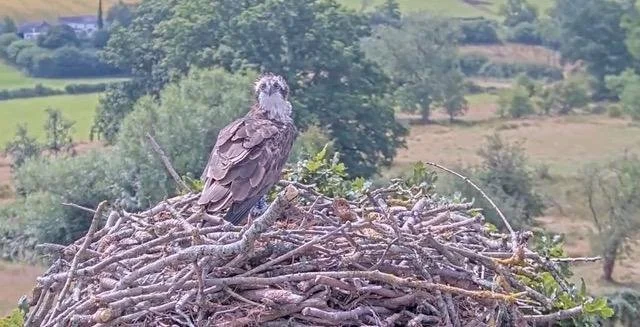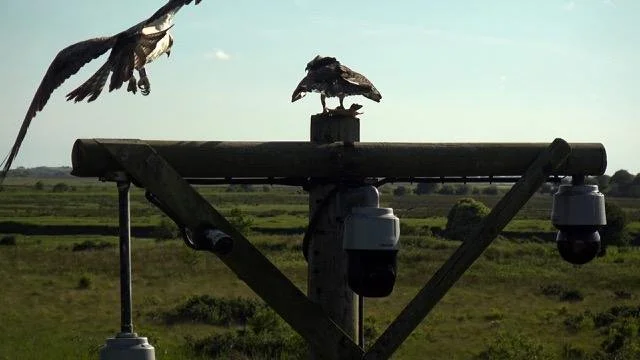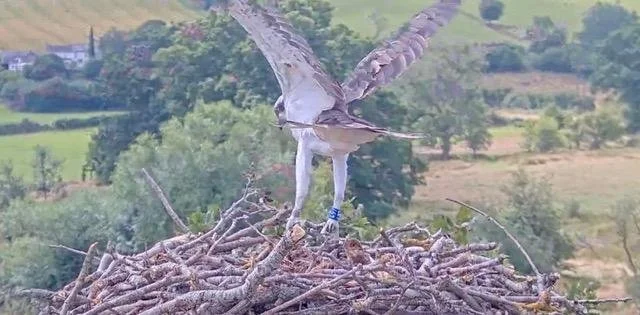Identity Issues
As all our dedicated osprey watchers have discovered in recent months, there can be times when it is quite difficult to identify osprey individuals from a small screen in front of you. Recording which bird is present in real time can be tricky. If the bird flies in and lands with its back to the camera it can be especially challenging. Second opinions from the support team are always available, expert opinion can also be sought if necessary, but usually the use of slowed down footage and screen shots can provide the answers.
Gilestone nest 6 August 2024 - resisting identification
Even seasoned experts in their field can sometimes struggle with some aspects of identity and for perfectly valid reasons. One such example came to light last week, when a ringed osprey intruded at the Gilestone Farm nest. The footage was slowed, the screenshots taken and the ring number was read without too much difficulty - Blue 497. So far so good. Then came the pleasurable task of reporting the sighting. First of all to the Roy Dennis Wildlife Foundation (who issue the coloured “Darvic” rings and who pass the information to the ringer) then to the osprey project where the bird was hatched, and finally to the County Bird Recorder. These steps were all taken prior to any consideration of announcing the visitor publicly.
By kind permission of Bywyd Gwyllt Glaslyn Wildlife - 497 on ringing day
Blue 497 was Welsh born and hatched at the Glaslyn nest in 2022. A much celebrated bird, being the fiftieth chick for “Mrs G”. But although they themselves had referred to this bird as “female” in the past, when Glaslyn replied to UVO they explained that there had never been solid confirmation of its sex. Researching this bird’s history online it was clear that it had been referred to as both male and female over the past two years, depending on where you looked.
When osprey chicks are ringed they are also weighed and measured and it is largely (though not exclusively) these measurements which contribute to the identification of its sex. The females are usually bigger and heavier than the males. At a given age there is a point on that sliding scale at which, under a certain weight will “likely” be a male and over it “likely” female. But in the case of 497, it could have gone either way and the ringer, hugely respected and very experienced with ospreys, could not ascertain the sex with any degree of certainty. At just 4-5 weeks of age this is not surprising. In a nutshell, 497 was either a large male or a small female.
It is always very exciting when a ringed osprey, especially a young and inexperienced one, is sighted safe and well at its wintering grounds. 497 was photographed during the winters of both 2022 and 2023 in Senegal by the project leader from Kielder Ospreys. Glaslyn explained that the winter 2022 observations and images suggested 497 looked more like a male. But then in the following winter this looked less likely - they would have to hope that 497 would be seen in the UK on his or her return.
By kind permission of MWT - Dyfi Osprey Project. June 2024 - 497 (left) intrudes at DOP on their camera pole
The next sighting was on 16th June 2024 at the Dyfi Osprey Project (DOP). 497 had made it safely back to the UK which was great news for Glaslyn. But the images taken on this occasion had 497’s back to the camera, and while it did allow the ring to be seen and to observe that the legs were fairly slim (a male characteristic), it could not provide a conclusive answer as to the sex.
The UVO screenshot images of 497 landing and taking off at Gilestone on 6th August were nowhere near the photographic quality of those produced at DOP and were still far from ideal in what they captured.
497 landed with its back to the camera, stayed only briefly and took off, again in the wrong direction. This meant that the desired views of the underwing were only partial. But they were sent to Glaslyn on request, who passed them on to Dr Tim Mackrill of the Roy Dennis Wildlife Foundation, together with a detailed history and other images for consideration. His reply came back “497 definitely looks like a male”.
Being a male osprey, 497 would have been far more likely to head for his natal area in Wales than not on his first return to the UK. This fits with the location reports so far and perhaps he has even been home to the Glaslyn Valley but unobserved.
UVO wish him well and are glad to have been able to contribute, along with the other projects involved, by providing a tiny piece of the jigsaw that, taken as a whole, may finally have confirmed his full identity




